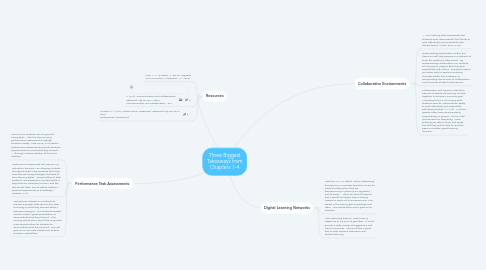Three Biggest Takeaways from Chapters 1-4
by Melanie Richardson

1. Performance Task Assessments
1.1. Some of our students are not good at taking tests. I like the idea of using performance assessments to gauge student's ability. Hale (2013, p.18) stated performance assessments provide students opportunities to prove what they learned "...through a demonstration of his or her abilities".
1.2. Performance assessment will improve my instruction because I am allowing students the opportunity to demonstrate what they have learned using strategies that best fit their learning styles. Using traditional tests students "are assessed on isolated skills in ways that are unfamiliar to them, and the test results often do not reflect children's personal experiences or knowledge" (Meisels, n.d.).
1.3. Last year we allowed our students to present a google slide show to the class summing up what they learned about a species of penguin. The students worked hard to create a great presentation to demonstrate what they learned. This coming school year I would like to provide more opportunities for students to demonstrate what they learned. This will give me an accurate assessment of each student's capabilities.
2. Resources
2.1. Hale, J. A., & Fisher, M. (2013). Upgrade Your Curriculum. Alexandria, VA: ASCD.
2.2. A. (n.d.). Communication and Collaboration. Retrieved July 20, 2017, from Communication and Collaboration - P21
2.3. Meisels, S. J. (n.d.). Performance Assessment. Retrieved July 20, 2017, from Performance Assessment
3. Collaborative Environments
3.1. "...21st Century Skills emphasizes that students must 'demonstrate [the] ability to work effectively and respectfully with diverse teams'" (Hale, 2013, p.22).
3.2. Implementing collaboration within the classroom will help prepare our students to enter the workforce after school. By implementing collaboration our students are learning to express their thoughts, respectfully, with others. Sometimes peers are better able to explain confusing concepts better than teachers, so incorporating the amount of collaboration could increase student achievement.
3.3. Collaboration will improve instruction, because students are learning to work together to achieve a common goal. According to the 21st Century skills students need to "demonstrate ability to work effectively and respectfully with diverse teams" (A, n.d.). My third graders often have issues working cooperatively in groups. This is a skill that we work on frequently. When students are able to learn and apply this skill they will be able to use their peers as another great learning resource.
4. Digital Learning Networks
4.1. Hale (2013, p.11) stated "active networking through DLN's increases teachers' access to orbits of ability when they are brainstorming or planning an upgraded unit of study". There are several subjects that it would be helpful when creating lessons to reach out to someone who is an expert in the area to gain knowledge and ideas. This would allow me to grow as an educator.
4.2. When planning lessons I could use my references in my DLN to get ideas. It could provide a wide variety of suggestions and links to resources. This would be a great tool to help improve instruction and student learning.


